The Grapes of Wrath (John Ford, 1940)
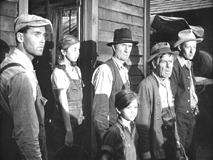 John Ford’s The Grapes of Wrath is
a thoroughly respectable and consistently accomplished adaptation of the
celebrated book about an Oklahoman family forced by circumstance to migrate west
and become migrant field workers. John Steinbeck’s novel is one of the
cornerstones of our nation’s Liberal consciousness, and Ford begins to impart
Liberal messages from the very first scene, in which recently released convict
Tom Joad (Henry Fonda, in a fine performance) appeals to a stranger’s sense of
compassion and hitches a ride in defiance of “the man”. That notion of
“the man” is perceivable everywhere here. There’s no one for the spurned
sharecroppers of the Dust Bowl to threaten with their shotguns because there’s
no individual to blame for the system’s failures. To combat that feeling of
hopelessness, the movie, like the novel it’s based on, adopts an increasingly
explicit sense of solidarity. The loner Tom Joad is the only character at first,
but he soon begins to accumulate friends, and then reacquaints himself with his
family unit, who, as a collective, then become more important to the film than
Tom is as an individual. Finally, in Tom’s final call for solidarity among
workingmen, there’s the suggestion that our focus should move beyond the
family unit to a larger, more universal social conscience.
John Ford’s The Grapes of Wrath is
a thoroughly respectable and consistently accomplished adaptation of the
celebrated book about an Oklahoman family forced by circumstance to migrate west
and become migrant field workers. John Steinbeck’s novel is one of the
cornerstones of our nation’s Liberal consciousness, and Ford begins to impart
Liberal messages from the very first scene, in which recently released convict
Tom Joad (Henry Fonda, in a fine performance) appeals to a stranger’s sense of
compassion and hitches a ride in defiance of “the man”. That notion of
“the man” is perceivable everywhere here. There’s no one for the spurned
sharecroppers of the Dust Bowl to threaten with their shotguns because there’s
no individual to blame for the system’s failures. To combat that feeling of
hopelessness, the movie, like the novel it’s based on, adopts an increasingly
explicit sense of solidarity. The loner Tom Joad is the only character at first,
but he soon begins to accumulate friends, and then reacquaints himself with his
family unit, who, as a collective, then become more important to the film than
Tom is as an individual. Finally, in Tom’s final call for solidarity among
workingmen, there’s the suggestion that our focus should move beyond the
family unit to a larger, more universal social conscience.
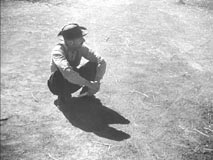 Based on a political novel initially
designed to promote the good work being done through the US Department of
Agriculture’s California-based sanitary transient camp program, the movie
fulfills Steinbeck’s political goals without sacrificing its newfound function
as Hollywood-style edification (or a vehicle for Ford’s expression). When the
script asks viewers to shift our attention away from the Joad family and onto
the need to organize labor, the scenes are dramatized intelligently enough (e.g.
casually, the threat of Communism is presented as a ploy used by the fat cats)
that edification doesn’t get in the way of the plot. Tom gets caught up in a
struggle that he doesn’t believe in, but as he learns from his circumstances
and begins to come around to the cause, the reasons he ought to become obvious
to the audience. Things look bleak in the last reel of The Grapes of Wrath,
but Tom’s political optimism allows the film to end on a somewhat optimistic
note, precisely because the movie has done such an excellent job at politicizing
the personal story it tells.
Based on a political novel initially
designed to promote the good work being done through the US Department of
Agriculture’s California-based sanitary transient camp program, the movie
fulfills Steinbeck’s political goals without sacrificing its newfound function
as Hollywood-style edification (or a vehicle for Ford’s expression). When the
script asks viewers to shift our attention away from the Joad family and onto
the need to organize labor, the scenes are dramatized intelligently enough (e.g.
casually, the threat of Communism is presented as a ploy used by the fat cats)
that edification doesn’t get in the way of the plot. Tom gets caught up in a
struggle that he doesn’t believe in, but as he learns from his circumstances
and begins to come around to the cause, the reasons he ought to become obvious
to the audience. Things look bleak in the last reel of The Grapes of Wrath,
but Tom’s political optimism allows the film to end on a somewhat optimistic
note, precisely because the movie has done such an excellent job at politicizing
the personal story it tells.
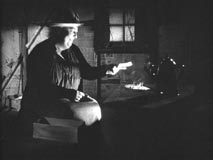 There are scenes here that are worthy of
Steinbeck’s writing. The fallen preacher Casy, played by John Carridine,
who’s effective even when he’s at his showiest, gives an affecting
explanation of his weary resignation to Godlessness (“So maybe there ain’t
no sin, and there ain’t no virtue. It’s just what people does… and
that’s all any man’s got a right to say.”). The sale of a fifteen-cent
loaf of bread incisively, and movingly, paints the outsiders’ attitude toward
the migrating Okies. The scenes of the Joad on the road in the jalopy, which
comprise a large percentage of the running time, provide the audience with one
of the defining images in American cinema. Perhaps most indelible of all is the
quiet scene in which Ma Joad burns the mementos and postcards from her shoebox
hope chest before leaving the only home she’s ever known. Gregg Toland’s
rich black and white cinematography is as impressive here as in any of the films
he’s shot. There’s an astonishingly dark scene, supposedly lit only by the
light of one candle, as Tom returns to his dilapidated homestead that is a
miracle of photographic expression (later perfectly echoed by Tom’s candlelit
last look at his mother before he flees), but largely the visuals of the movie
alternate between documentary realism and a studio’s best approximation of it.
The sets, which are frequently obvious as sets, still manage to convey the shock
of Depression-era desolation, casting the characters against swirling skies and
vast landscapes that dwarf them. The starkness of the transient camps is still
startling today (though lessened somewhat by the inclusion of Ma Joad’s
didactic act of charity). Throughout, Ford’s ability to energize and humanize
even the most instructive of scenes here proves that drama trumps dictation when
it comes to raising the audience’s political consciousness.
There are scenes here that are worthy of
Steinbeck’s writing. The fallen preacher Casy, played by John Carridine,
who’s effective even when he’s at his showiest, gives an affecting
explanation of his weary resignation to Godlessness (“So maybe there ain’t
no sin, and there ain’t no virtue. It’s just what people does… and
that’s all any man’s got a right to say.”). The sale of a fifteen-cent
loaf of bread incisively, and movingly, paints the outsiders’ attitude toward
the migrating Okies. The scenes of the Joad on the road in the jalopy, which
comprise a large percentage of the running time, provide the audience with one
of the defining images in American cinema. Perhaps most indelible of all is the
quiet scene in which Ma Joad burns the mementos and postcards from her shoebox
hope chest before leaving the only home she’s ever known. Gregg Toland’s
rich black and white cinematography is as impressive here as in any of the films
he’s shot. There’s an astonishingly dark scene, supposedly lit only by the
light of one candle, as Tom returns to his dilapidated homestead that is a
miracle of photographic expression (later perfectly echoed by Tom’s candlelit
last look at his mother before he flees), but largely the visuals of the movie
alternate between documentary realism and a studio’s best approximation of it.
The sets, which are frequently obvious as sets, still manage to convey the shock
of Depression-era desolation, casting the characters against swirling skies and
vast landscapes that dwarf them. The starkness of the transient camps is still
startling today (though lessened somewhat by the inclusion of Ma Joad’s
didactic act of charity). Throughout, Ford’s ability to energize and humanize
even the most instructive of scenes here proves that drama trumps dictation when
it comes to raising the audience’s political consciousness.
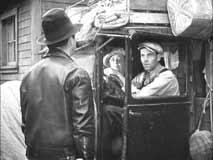 Some flaws detract, though not fatally,
from the experience. There are many theatrical performances here, but a few of
the actors -- specifically Jane Darwell and Charley Grapewin as Ma and Grandpa
Joad -- are clearly overacting. There’s the disturbing notion here, too, that
it’s the suffering the Joads face is what ennobles them. Too often, the
familiarity of the narrative structure creates a comfort level that suppresses
the sense of outrage that the audience might feel at seeing the social
injustice. The flashbacks in the first act don’t quite flow as well as the
rest of the film. Ma’s bedside speech to Tom about the importance of family,
at least as presented here, is the worst kind of phony Hollywood corn, and I’m
not quite sure what to make of the last shot, which places a “DANGER” sign
in the same frame as a row of migrant workers’ cars. It’s a decidedly
different parting scene than the novel’s, and that might be because
Rosasharn’s part is cut down considerably from the source material. There’s
little denying that her relationship with Ma Joad doesn’t resonate here to the
extent that Tom and Casy’s does. This is not damning, though it renders Ma’s
final speech about the differences between the female and male perspective
somewhat out of place. It also has to be said that her final, “I ain’t never
gonna get scared no more,” feels forced in everything but the sense of
nostalgia and loss that surrounds the sentiment. Here, more than anywhere else
in the film, we’re getting values that belong to Ford more than Steinbeck.
Some flaws detract, though not fatally,
from the experience. There are many theatrical performances here, but a few of
the actors -- specifically Jane Darwell and Charley Grapewin as Ma and Grandpa
Joad -- are clearly overacting. There’s the disturbing notion here, too, that
it’s the suffering the Joads face is what ennobles them. Too often, the
familiarity of the narrative structure creates a comfort level that suppresses
the sense of outrage that the audience might feel at seeing the social
injustice. The flashbacks in the first act don’t quite flow as well as the
rest of the film. Ma’s bedside speech to Tom about the importance of family,
at least as presented here, is the worst kind of phony Hollywood corn, and I’m
not quite sure what to make of the last shot, which places a “DANGER” sign
in the same frame as a row of migrant workers’ cars. It’s a decidedly
different parting scene than the novel’s, and that might be because
Rosasharn’s part is cut down considerably from the source material. There’s
little denying that her relationship with Ma Joad doesn’t resonate here to the
extent that Tom and Casy’s does. This is not damning, though it renders Ma’s
final speech about the differences between the female and male perspective
somewhat out of place. It also has to be said that her final, “I ain’t never
gonna get scared no more,” feels forced in everything but the sense of
nostalgia and loss that surrounds the sentiment. Here, more than anywhere else
in the film, we’re getting values that belong to Ford more than Steinbeck.
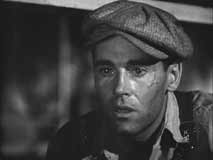 These are small complaints, however,
since The Grapes of Wrath largely does a great novel proud (albeit within
the constraints of Hollywood filmmaking of the era). For example, there’s more
genuine tension in the movie’s dance scene than the novel’s. The Joad
family’s limited level of comfort is even easier to appreciate when it’s
being represented pictorially, and when a situation, augmented by Ford’s
considerable skills as a director, threatens it, there’s a more palpable sense
of injustice than Steinbeck’s pen provides. The train whistle blowing in the
distance and the reprise of “Red River Valley” in Tom’s final scene are
clearly Fordian touches that add a brand of poignancy that is only possible in
cinema. The directorial choices here are more evocative of the mood than the
(suitably) inarticulate dialogue that the characters speak, and once again
remind the audience of the sort of emotional directness that’s more easily
achieved in filmed mediums than written ones. Most importantly of all, however,
is that Ford delivers Steinbeck’s message intact. That Tom still says, “A
fellow ain’t got a soul of his own. Just one piece of a soul that belongs to
everybody,” and does it without forcing the issue, is The Grapes of Wrath’s
prime achievement.
These are small complaints, however,
since The Grapes of Wrath largely does a great novel proud (albeit within
the constraints of Hollywood filmmaking of the era). For example, there’s more
genuine tension in the movie’s dance scene than the novel’s. The Joad
family’s limited level of comfort is even easier to appreciate when it’s
being represented pictorially, and when a situation, augmented by Ford’s
considerable skills as a director, threatens it, there’s a more palpable sense
of injustice than Steinbeck’s pen provides. The train whistle blowing in the
distance and the reprise of “Red River Valley” in Tom’s final scene are
clearly Fordian touches that add a brand of poignancy that is only possible in
cinema. The directorial choices here are more evocative of the mood than the
(suitably) inarticulate dialogue that the characters speak, and once again
remind the audience of the sort of emotional directness that’s more easily
achieved in filmed mediums than written ones. Most importantly of all, however,
is that Ford delivers Steinbeck’s message intact. That Tom still says, “A
fellow ain’t got a soul of his own. Just one piece of a soul that belongs to
everybody,” and does it without forcing the issue, is The Grapes of Wrath’s
prime achievement.
75
Jeremy Heilman
06-05-04